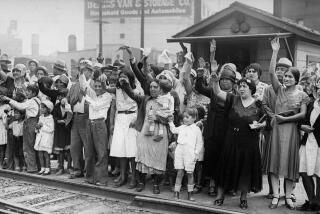Mexico, Ireland Share the Bond of an Ill-Fated Army
- Share via
They were celebrated as war heroes in Mexico, hanged as traitors by the U.S. Army, and forgotten back in famine-racked Ireland.
Last week, Ireland and Mexico honored the quixotic saga of the St. Patrick’s battalion, an ill-starred column of Irish immigrants recruited by the American military to fight in the Mexican-American War.
When the Irishmen defected to the Mexican side and fought American troops under a green silk banner emblazoned with St. Patrick, a shamrock and the traditional harp of Erin, they earned the wrath of the U.S. military and the everlasting admiration of Mexico.
For years an obscure historical footnote, the story is being dusted off today as an allegory for the plight of immigrants, a morality tale on the implacability of Manifest Destiny, and an example of the bond of Irish-Mexican solidarity in an era of increasing mutual trade.
On Friday, Mexican President Ernesto Zedillo commemorated the 150th anniversary of the execution of the San Patricios at a ceremony in Mexico City’s San Jacinto Plaza, where the first of 50 hangings were staged. Irish President Mary Robinson was host of a celebration in Dublin on Tuesday, three days before handing over her post.
Both countries issued commemorative postage stamps.
“There are deep affinities between the Irish character and the Mexican character,” said Daniel Dultzin, Mexico’s ambassador to Dublin. “The San Patricios fought bravely. To us, they are true heroes.”
The tale of divided loyalties has enjoyed cult status in California Irish pubs and clubs for several years. A play was staged in Santa Cruz and Los Angeles, and a San Patricios column marches in the San Francisco St. Patrick’s Day parade.
There is even a Hollywood benediction in the offing, called “One Man’s Hero.” Starring Tom Berenger and Mexico’s Daniela Romo, it begins production in Durango on Friday, said its publicist, Bob Rooney.
The San Patricios have inspired nostalgia in Mexico for years. A plaque with their names (the Irish get the limelight, but some were German and American) hangs in San Jacinto Plaza. There is a San Patricios public school.
The story will be recounted to Irish and Mexican television audiences in a documentary by a San Diego independent filmmaker, Mark Day.
The documentary revisits an era in America--before Irish cops and the Kennedys--when the Irish were an immigrant “problem.”
The U.S. anti-immigrant press of the time caricatured the Irish with simian features, portraying them as unintelligent and drunk and charging that they were seditiously loyal to the pope. At least 20 people were killed and two churches were burned in anti-Catholic riots in Philadelphia during that era, and a mob in Massachusetts burned a convent.
But cheap Irish labor was welcome. Irish maids became as familiar as Latin American nannies are today.
By the first rumblings of the Mexican-American conflict in 1846, the first of millions of Irish were already streaming to America, fleeing burgeoning famine and the disenfranchisement of the English occupation.
Thousands joined the U.S. Army at $7 a month and were marched south.
It was a Galway man, John Riley, who first deserted, swimming across the Rio Grande after asking permission to go to Mass.
As the U.S. Army marched through Mexico’s northern deserts, others followed, and Riley became captain of a 200-member rogue column in the Mexican army. At San Luis Potosi, convent nuns presented them the hand-stitched banner that foreshadowed their eventual romanticization.
Some say the Irish were lured to desert by promises of Mexican land grants. Others blamed Mexico’s Catholicism, and a few priests were arrested.
At the Friday ceremony, Mexican President Zedillo called the desertions “an act of conscience” and said the men “listened to the voice of justice, dignity and honor, and joined Mexican patriots who faced an aggression that lacked any justification.”
At their court-martial, most San Patricios said they had been forced to desert by the Mexicans, or had too much to drink.
“They needed an excuse. They couldn’t say ‘I hated the United States,’ so they said they weren’t responsible,” said Robert Ryal Miller, whose San Patricios book, “Shamrock and Sword,” just came out in paperback.
Miller, a retired Cal State Hayward history professor, thinks the deserters fled harsh treatment.
“Anglo soldiers often harassed them, beat them up,” he said.
*
The U.S. Army captured most of the surviving San Patricios when they overran the convent of Churubusco on Aug. 20, 1847. Among those demanding harsh punishment for the San Patricios were thousands of Irish non-deserters--who felt the renegades intensified anti-immigrant prejudice--and one of the American commanders, Lt. Col. William Harney.
Harney had a chilling resume, even in an era that sanctioned brutality in the name of western expansion. Wanted in St. Louis for beating his slave housekeeper to death, he was notorious for ravishing and hanging Indian women, Miller and other historians say.
At the court-martial, one Irishman, Patrick Dalton, gave a rambling delivery of self-aggrandizing anecdotes and descriptions of the Mexican countryside that careened between blarney and malarkey, according to historian Michael Hogan.
He was hanged anyway, with 49 others, in a series of public executions in mid-September 1847 that Miller said was the largest in U.S. military history.
At least 16 San Patricios were spared death, and to the ire of U.S. commanders, one was suspected ringleader John Riley. War had not been formally declared when he deserted.
Instead they were horsewhipped, branded with a D on their faces, and drummed out in disgrace.
In 1848, the United States signed the treaty that ended the war and took possession of a third of Mexican territory, including California, and the tale of the San Patricios was abandoned, until recently, to the dusty bowels of U.S. military archives in Washington.
“This is a story about assimilation,” said Peter F. Stevens, a Boston historian whose San Patricios book, “The Rogue’s March,” is due out this spring. “A lot of these guys deserted because of the anti-Catholic, anti-foreigner movement. America was trying to grapple with an unprecedented immigrant wave, just as we are today.”
More to Read
Sign up for Essential California
The most important California stories and recommendations in your inbox every morning.
You may occasionally receive promotional content from the Los Angeles Times.










